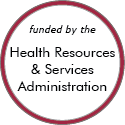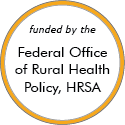Rural Project Examples: Healthcare needs and services
Other Project Examples
Kid One Transport
Updated/reviewed June 2025
- Need: Transportation to medical appointments for children and expectant mothers living in rural Alabama.
- Intervention: Kid One Transport provides rides to medical appointments for clients who otherwise have no other means of transportation.
- Results: The program has transported 477,880 children and expectant mothers to and from medical appointments. Children have recovered from life-threatening illnesses and are experiencing a higher quality of life.
Structured Training for Rural Enhancement of Community Health in Obstetrics (STRETCH-OB)

Updated/reviewed June 2025
- Need: To improve maternal and birth outcomes in rural and underserved areas by increasing the number of family medicine physicians in these areas who have high-quality, evidence-based obstetrical care skills.
- Intervention: The STRETCH-OB program trains a select number of family medicine residents at the University of Illinois College of Medicine Rockford each year to provide high-quality maternity care, including surgical obstetrical care.
- Results: Four STRETCH-OB residents have graduated as of June 2025 and all have cesarean section privileges in their practice.
The Sapling Center
Updated/reviewed June 2025
- Need: To create a safe space for youth and young adults, ages 14 to 25, in rural eastern Kentucky.
- Intervention: The Sapling Center provides independent living skills education and offers a wide array of services as well as fun activities in a supportive environment.
- Results: The 5 Sapling Center locations serve 50-75 teens and young adults every day.
Together We Can Be Bully Free
Updated/reviewed June 2025
- Need: Union Parish, a rural county in Louisiana, continues to experience elevated rates of youth suicide, bullying, mental health challenges, and risk behaviors, as confirmed by a 2024 Community Health Needs Assessment (CHNA).
- Intervention: Union General Hospital, a Critical Access Hospital, started a program to educate students grade 4 through 12 on the negative effects of bullying, to foster positive social behavior, and to provide mental health support through school-based interventions.
- Results: Over 3,500 students have learned how to recognize, report, and respond to bullying. The program's integration with broader community health priorities has strengthened mental health, reduced suicide attempts, and improved awareness of youth risk behaviors.
Positively Living & Choice Health Network
Updated/reviewed May 2025
- Need: To provide affirming, destigmatized healthcare and support to thousands of Tennesseans living with HIV/AIDS, mental illness, substance use disorder, and homelessness – and prevention services for individuals at risk of contracting HIV.
- Intervention: Positively Living & Choice Health Network provides services including a medical clinic, pharmacy, therapy, case management, client services like housing aid and transportation, HIV prevention, and a harm reduction program.
- Results: The program currently serves 5,000 individuals and families through its offices in Knoxville, Chattanooga, Memphis, and Cookeville and its mobile medical unit for rural communities in Cocke and Claiborne counties.
Project ACTIVATE (Advancing Coordinated and Timely InterVentions, Awareness, Training, and Education)
Updated/reviewed May 2025
- Need: To improve students' access to behavioral health services in rural North Carolina.
- Intervention: North Carolina Project ACTIVATE provides three tiers of behavioral health supports in the school setting.
- Results: The six pilot sites (Cohorts 1 and 2) have created or revised 91 mental health policies, and 48,531 school-based and related employees have received training in different topics and protocols.
Queen Anne's County Mobile Integrated Community Health (MICH) Program
Updated/reviewed May 2025
- Need: To connect patients to resources in order to reduce use of emergency services, emergency department visits, and hospital readmissions.
- Intervention: Patients receive support (by in-person visit, phone call, or telehealth visit) from a paramedic, community health nurse, peer recovery specialist, and pharmacist.
- Results: Between July 2016 and March 2024, the program made 1,098 patient contacts and continued to see a reduction in emergency department and inpatient visits and costs.
Community Care Partnership of Maine Accountable Care Organization

Updated/reviewed April 2025
- Need: To increase access and quality of care for patients in rural Maine.
- Intervention: Community hospitals and Federally Qualified Health Centers in Maine formed the Community Care Partnership of Maine Accountable Care Organization (CCPM ACO).
- Results: CCPM serves about 120,000 patients in Maine. In addition, it has implemented shared savings arrangements/contracts with different Medicare Advantage and other private health payers.
Delta Dental Mobile Program
Updated/reviewed April 2025
- Need: Lack of access to oral healthcare for children from limited-income families in the rural and urban areas of South Dakota.
- Intervention: Delta Dental of South Dakota launched the Delta Dental Mobile Program in 2004 to expand access to oral healthcare services to children throughout the rural state.
- Results: The Delta Dental Mobile Program has provided over $44 million in dental care to more than 73,000 South Dakota children.
Mother's Milk Bank of South Carolina
Updated/reviewed April 2025
- Need: Neonatal Intensive Care Units (NICUs) across the state of South Carolina were purchasing breast milk from out-of-state milk banks for preterm infants.
- Intervention: The Mother's Milk Bank of South Carolina (MMBSC) opened 25 sites in South Carolina for breast milk to be donated, safely pasteurized, and delivered to NICUs across the state.
- Results: Over 24,320,167 ounces of milk have been donated to MMBSC depot sites and over 14,932,920 ounces of milk have been delivered to South Carolina NICUs.
For examples from other sources, see:
